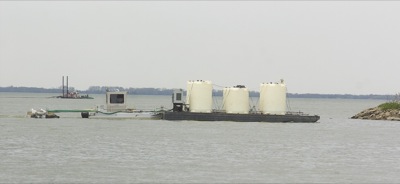Friday, April 20th, 2012
Lake alum on schedule
By Nancy Allen

Photo by Mark Pummell/The Daily Standard
One of two alum barges on Grand Lake returns to the state park office near St. Marys on Thursday morning. A whole-lake treatment of alum to stave off blue-green algae blooms is underway. The dredge Brutus is pictured in the background.
GRAND LAKE - A $5 million alum application on Grand Lake to stifle blue-green algae blooms is on schedule despite recent windy conditions.
"As of today, they are about 60 percent complete, and they lost about four days to wind," Grand Lake St. Marys State Park Manager Brian Miller said this morning. "A couple of times, it was a half a day here and a half a day there."
Officials with HAB Aquatic Solutions, Lincoln, Neb., are applying about 3.5 million gallons of liquid alum and sodium aluminate to the entire lake. The staging area for the two barges has been moved from the west side of the lake to the east side.
Alum deactivates phosphorous, the main nutrient feeding the lake's algae that has resulted in advisories and millions in lost tourism dollars the last three summers. Most of the phosphorous that runs off into the 13,500-acre lake comes from farmland, the largest land use in the 58,000-acre watershed. Sodium aluminate keeps pH levels from fluctuating so fish aren't stressed and damage to boat hulls is reduced. Alum is not harmful to aquatic life or humans, information from the Ohio EPA says.
Officials hope the treatment, which began April 2, results in an advisory-free lake this summer, and visitors will return to Ohio's largest inland lake.
State officials continue to check the water's dissolved oxygen and pH levels using four in-lake monitoring stations. The same monitoring was completed last year when the state treated the center of the lake at a cost of $3.4 million.
"Last year since we did it later, it was critical that we watched the (dissolved oxygen) levels because we already had such a big algal bloom that made DO low," Miller said. "So far with this year's application, we have not seen any low DO levels."
The treatment in 2011 took place June 2-30. It reduced phosphorous levels in the lake's center 56 percent and 20-30 percent in untreated areas. It was scaled back from a whole lake treatment over concerns that already high algae concentrations and low oxygen levels could cause a massive fish kill.
ODNR spokeswoman Bethany McCorkle today said the state hopes for phosphorous reductions equal to or better than last year's treatment. A full report on the results should be available in September, she said.
Miller said HAB's contract says the company has 45 days to complete the treatment, but their goal is 30.
Debbie Wolters, fish management supervisor with the Ohio Division of Wildlife's District 5 office in Xenia, said the death of some walleye and sheephead fish found along the lake's north shore was not caused by alum.
Wolters said wildlife officials do not know exactly why the fish died. Fish deaths typically are related to water quality, disease or human activity, she said.
"It is usually related to dissolved oxygen changes in the water, but we checked that, and it was in the good range and not the cause," she said. "Because of that, we determined alum was not the cause."
Wolters said wildlife officials could not rule out disease because the fish had been dead more than 24 hours.
Many fish are spawning, which weakens them and can lower their resistance to disease, she said. Wolters informed Miller's staff to keep her office apprised of any more fish deaths or signs of sickness or stress.
Wildlife officials counted about 150 dead fish, a small amount compared to the size of the lake, she said. A concern would exist if there were thousands, she added.
Funding for this year's treatment is coming from about $1.6 million in Ohio EPA Water Pollution Control Loan funds left over from last year's treatment and the rest from the Ohio Water Development Authority's Distressed Watershed Loan Program.
Alum is being used as a short-term solution to bring back visitors to Grand Lake until long-term actions involving better manure management and installing conservation practices reduce phosphorous runoff.
The state this year also will continue to help with removing rough fish, such as carp and shad that rile up the lake phosphorus in the lake's bottom; increase dredging; install a treatment train at Prairie Creek; and complete other watershed improvement initiatives.



